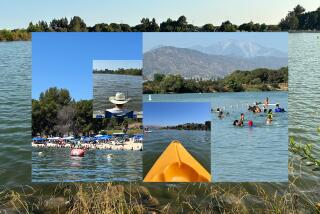Titan: Land o’ methane lakes
- Share via
New images captured by NASA’s Cassini spacecraft reveal a land of liquid methane and ethane lakes spotting the north pole of Titan, Saturn’s largest moon.
NASA’s Jet Propulsion Laboratory in La Cañada Flintridge released the new images this week, saying that a fortunate coincidence of seasonal change and spacecraft positioning made the pictures possible.
“The view from Cassini’s visual and infrared mapping spectrometer gives us a holistic view of an area that we’d only seen in bits and pieces before and at lower resolution,” read a statement from Jason Barnes, a participating scientist at the University of Idaho, Moscow.
“It turns out that Titan’s north pole is even more interesting than we thought.”
Titan is the only body in the solar system, other than Earth, that features stable bodies of liquid on its surface, according to NASA.
These dark hydrocarbon lakes are concentrated around the north pole, although there is one larger lake and several smaller ones near the south pole.
Scientists have been trying to determine why this is the case, and say it may have to do with different terrain in the north.
Mosaic infrared images reveal that the northern lakes are “embedded in some kind of bright surface material,” researchers wrote.
Scientists say the images suggest that some of the liquid bodies have evaporated, and left behind a crust of organic chemicals -- similar to salt flats on Earth.
Launched in 1997, Cassini has been exploring Saturn and its moons for a decade. A full Saturn year is equivalent to 30 Earth years and seasons on Titan last much longer than ours as well.
Until now, much of Titan’s north pole remained hidden from Cassini’s cameras beneath a thick haze. That concealing cap has disappeared, though, as Titan’s northern hemisphere heads into its “summer” season.
“Titan’s northern lakes region is one of the most Earth-like and intriguing in the solar system,” said Linda Spilker, a Cassini project scientist at JPL. “We know lakes here change with the seasons, and Cassini’s long mission at Saturn gives us the opportunity to watch the seasons change at Titan, too.”
ALSO:
Do Jupiter and Saturn have diamond ‘rain’?
Astronomers discover most distant galaxy known
Found: A planet with no star, free-floating in space







